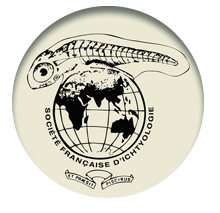Infection caused by the tapeworm Ligula intestinalis (Cestoda, Diphyllobothriidae) in the invasive cyprinid Rutilus rutilus (L., 1758), in three man-made lakes in Algeria
How to cite: Arab, I. Y., Arab, A., & Kara, M. H. (2021). Infection caused by the tapeworm Ligula intestinalis (Cestoda, Diphyllobothriidae) in the invasive cyprinid Rutilus rutilus (L., 1758), in three man-made lakes in Algeria. Cybium, 45(1): 43-52. https://doi.org/10.26028/CYBIUM/2021-451-005
This study is devoted to parasitism caused by the tapeworm Ligula intestinalis (L.) in the roach Rutilus rutilus (L.), an invasive species, in three Algerian dam lakes dependent on three different watersheds. We follow the quantitative parameters of parasitism and the impact of parasitism on the development of fish. From March 2016 to February 2017, we examined 578, 565 and 629 individuals in Sekkak, Ghrib and Guenitra dams respectively. The rate of infection varies depending on the site (p-value < 5%). The prevalence is 0.86% in Sekkak, 2.22% in Guenitra and 10.26% in Ghrib. Respectively, the mean intensity of infection is equal to 1.2, 5.2 and 1.3. The occurrence of the parasite is higher in all dams during autumn. Major allometric growth was observed in parasitized individuals in the three dams (b = 3.19 for Ghrib, b = 3.98 for Sekkak and b = 3.44 for Guenitra) and minor allometric growth in non-parasitized individuals (b = 2.98 to Ghrib, b = 2.98 to Sekkak and b = 2.92 to Guenitra), with a significant difference between parasitized and healthy individuals in the three dams (p < 5%). Overweight fish are influenced by parasitism in Ghrib dam (parasitized individuals: Kp = 1.03 ± 0.07 and healthy individuals: Ks = 1.06 ± 0.11 (p < 5%)) contrariwise to Sekkak and Guenitra (parasitized individuals: Kp = 1.09 ± 0.18 in Sekkak, 0.97 ± 0.09 in Guenitra; healthy individuals: Ks = 1.04 ± 0.14 in Sekkak, 1.03 ± 0.12 in Guenitra) (p > 5%). At Ghrib dam, the parasitism varies depending on the groups of both size and age (p < 5%), on the contrary to the condition factor (p > 5%).


